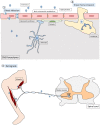Enterovirus and Encephalitis
- PMID: 32153545
- PMCID: PMC7044131
- DOI: 10.3389/fmicb.2020.00261
Enterovirus and Encephalitis
Abstract
Enterovirus-induced infection of the central nervous system (CNS) results in acute inflammation of the brain (encephalitis) and constitutes a significant global burden to human health. These viruses are thought to be highly cytolytic, therefore normal brain function could be greatly compromised following enteroviral infection of the CNS. A further layer of complexity is added by evidence showing that some enteroviruses may establish a persistent infection within the CNS and eventually lead to pathogenesis of certain neurodegenerative disorders. Interestingly, enterovirus encephalitis is particularly common among young children, suggesting a potential causal link between the development of the neuroimmune system and enteroviral neuroinvasion. Although the CNS involvement in enterovirus infections is a relatively rare complication, it represents a serious underlying cause of mortality. Here we review a selection of enteroviruses that infect the CNS and discuss recent advances in the characterization of these enteroviruses with regard to their routes of CNS infection, tropism, virulence, and immune responses.
Keywords: CNS; Picornaviridae; RNA virus; encephalitis; enterovirus.
Copyright © 2020 Chen, Lee, Lee, Gong and Shih.
Figures


References
-
- Anderson C. M., Nedergaard M. (2003). Astrocyte-mediated control of cerebral microcirculation. Trends Neurosci. 26 340–344; authorrely 344–345. - PubMed
Publication types
LinkOut - more resources
Full Text Sources
Other Literature Sources

